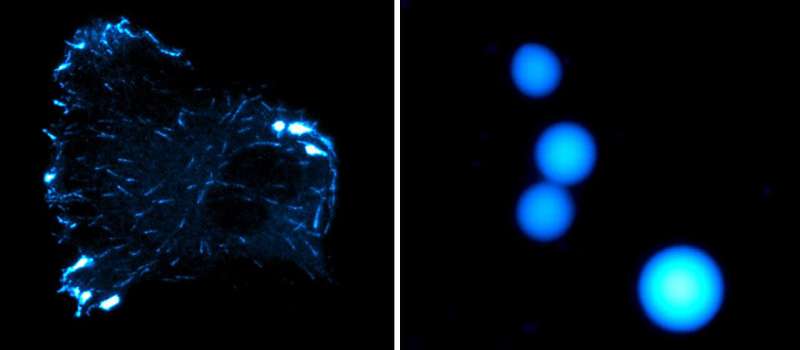This article has been reviewed according to Science X's editorial process and policies. Editors have highlighted the following attributes while ensuring the content's credibility:
fact-checked
peer-reviewed publication
trusted source
proofread
Deciphering the 'highway code' of our cells: Team identifies key mechanism in regulation of microtubules

Cancers, degenerative diseases: deregulation of our cells' internal communication pathways is at the root of many conditions. Microtubules—microscopic protein filaments—play a crucial role in controlling these exchanges. However, their mechanisms remain poorly understood.
A team from the University of Geneva (UNIGE) has identified a new mechanism, involving two proteins, that governs their growth. The discovery opens up unprecedented prospects for the development of new treatments that can act at the very heart of cells. These results are published in the Proceedings of the National Academy of Sciences (PNAS).
As a city needs fluid transport networks for its exchange and development, so cells need internal microscopic ''roads'' to supply themselves, grow and divide. These '"roads" are called "microtubules." They are long protein filaments that form the backbone of the cell. Problems with their regulation can cause diseases such as cancer and neurodegenerative disorders.
Understanding how they work—and in particular the mechanisms that control and regulate their growth—is therefore crucial. Although significant advances have been made in this field over the last forty years, the complexity of this system continues to require intense research.
Two key proteins
Recent work by Charlotte Aumeier, assistant professor in the Biochemistry Department at the UNIGE Faculty of Science, provides new insights into the functioning of the microtubule. It shows how two specific proteins, CLIP-170 and EB3, undergo liquid-liquid phase separation at the tip of the microtubule during its growth. In other words, these two proteins separate from the cellular liquid medium to form a second liquid phase at the tip of the microtubule, like a drop of oil in water.
Microtubules are dynamic structures that continually build and deconstruct themselves. "This phenomenon of phase separation, at the level of the microtubule, increases the concentration of proteins, including tubulin, and significantly stimulates the growth rate of microtubules while reducing depolymerisation events, i.e., microtubule decay events," explains Charlotte Aumeier, the last author of the study. This mechanism therefore seems to control the dynamics of cellular microtubules in a very concrete way.
Joint action
Julie Miesch, a Ph.D. student in Charlotte Aumeier's laboratory and first author of the study, explains that "it is the synergy between CLIP-170 and EB3 that ensures the regulation of microtubule growth, thanks to a liquid-liquid phase separation mechanism." Taken individually, CLIP-170 has no interaction with tubulin. As for EB3, although it is capable of interacting with tubulin, it only forms tiny aggregates on the surface. The combination of these two proteins makes it possible to regulate the speed of microtubule growth locally.
The role of these two proteins was observed by in vitro and then in cellulo measurements using a combination of two methods, total internal reflection fluorescence microscopy and high-throughput confocal microscopy, available at the UNIGE within the ACCESS GENEVA platform.
These results highlight a new level of regulation in the control of microtubule dynamics. This opens up the possibility of new targets in the development of new anti-cancer therapies. This breakthrough promises to further broaden our understanding and our ability to act at the very heart of cellular processes.
More information: Julie Miesch et al, Phase separation of +TIP networks regulates microtubule dynamics, Proceedings of the National Academy of Sciences (2023). DOI: 10.1073/pnas.2301457120
Journal information: Proceedings of the National Academy of Sciences
Provided by University of Geneva



















